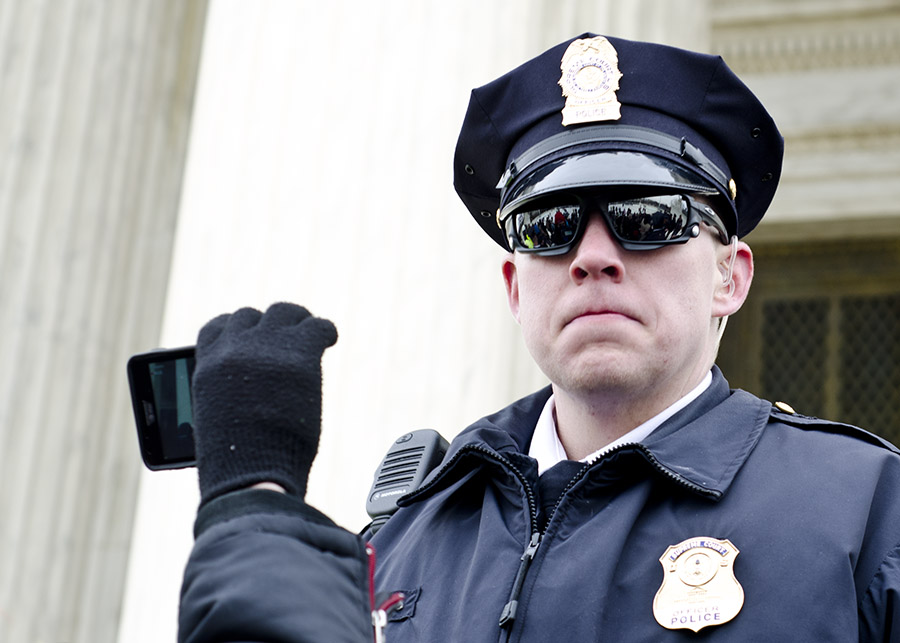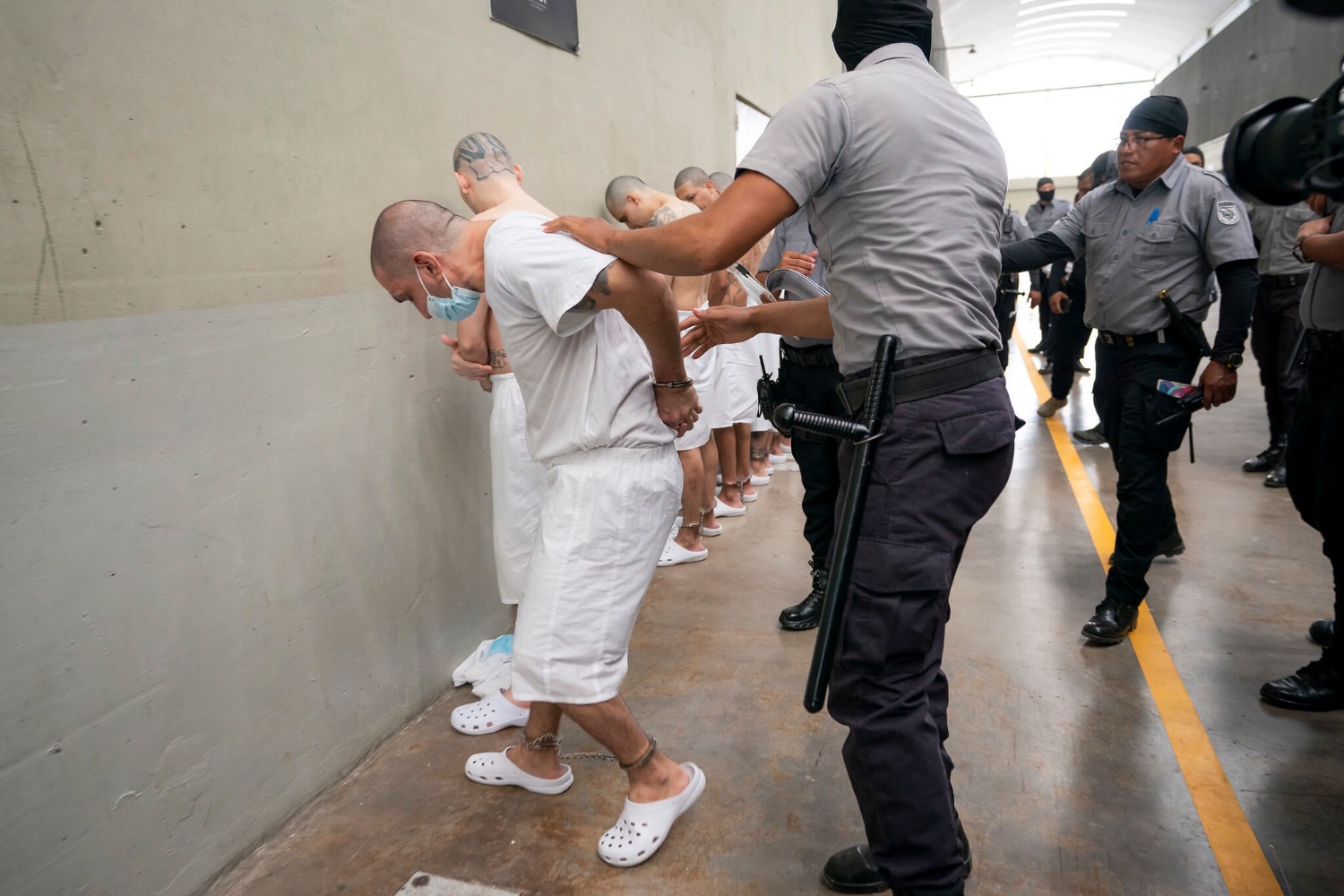Can Law Enforcement Officers Refuse to Identify Themselves?
It’s complicated.

Published by The Lawfare Institute
in Cooperation With

On June 3, protestors in Washington, D.C., who rallied in response to the death of George Floyd were met with federal law enforcement officers equipped with riot gear and rifles but who lacked badges or other identifying information. When asked about their affiliation, these officers responded that they worked for the Department of Justice or the federal government, but they did not offer more detail.
The officers’ refusal to identify themselves immediately sparked criticism. Observers raised concerns that this practice could lead protesters to resist lawful orders and create opportunities for armed provocateurs to pose as law enforcement. Some even drew comparisons to the armed and unidentified “little green men” who appeared in the Crimea region of Ukraine shortly before its 2014 occupation by Russia and were widely believed to be Russian soldiers operating anonymously.
Since the first days of protests in Washington, D.C., many of the unmarked officers have been identified as part of special operations response teams for the Bureau of Prisons. But the question remains: What legal authorities require officers to share their identities, and are there any consequences for failing to do so?
After news reports linked the unidentified officers to the Bureau of Prisons, Attorney General William Barr attempted to explain the officers’ behavior by stating that “[i]n the federal system, the agencies don’t wear badges with their names and stuff like that. I could understand why some of these individuals simply wouldn’t want to talk to people about who they are, if that in fact was the case.” Similarly, a statement from the bureau said that “[i]t is common for federal law enforcement agents to identify themselves to citizens simply as federal law enforcement.” However, the director of the bureau said, “I probably should have done a better job of marking them nationally as the agency.”
Nor was this the only instance of law enforcement officers attempting to hide or obscure their identities during the recent nationwide protests. In several cities, including Seattle, New York and Chicago, individuals also reported that a few police officers deployed to the protests covered their badge numbers with tape. Such obfuscation has been widely criticized, even by city officials. Chicago Mayor Lori Lightfoot stated that the officers who refused to identify themselves “forfeited the right to be Chicago police officers,” although she would not have the final say about whether to discipline the officers.
Broadly speaking, law enforcement officers do not have a legal duty to disclose either their identities or their agencies of affiliation, even if asked directly. Certain municipalities require police officers to identify themselves if asked, but there is currently no federal statute requiring officer disclosure of such information. Generally, federal law enforcement conduct is guided by the internal regulations of the particular law enforcement agency for whom the officers work—or, when federal officials are not involved, the regulations of local police departments.
For this reason, the majority of litigation analyzing law enforcement officers’ obligation to disclose their identities focuses on two scenarios that are somewhat inapposite to current events: undercover law enforcement operations and the potential for entrapment; and search and seizure cases implicating an individual’s Fourth Amendment rights. Courts have adopted a broad definition of seizure that includes displays of force and the use of language that implies compliance is required. Thus, the legal analysis underpinning the second scenario provides the clearest guidance on the standards courts would likely look to in litigation surrounding the recent failures of federal law enforcement officers to disclose their identities. Nevertheless, the current circumstances, where individuals are clearly law enforcement but refuse to identify themselves, present a distinct and novel issue.
The central question in analyzing such officers’ behavior would be whether or not it was “reasonable.” The Fourth Amendment precludes the government from conducting unreasonable searches and seizures, but, as the Supreme Court noted in Mapp v. Ohio (1961), there remains no fixed test for reasonableness. Instead, trial courts determine reasonableness using an objective standard on a case-by-case basis. The reasonableness inquiry under the Fourth Amendment focuses on the specific context and the threat that the suspect poses. In the event that an individual believes law enforcement failed to conduct a seizure reasonably, that individual may pursue a civil action against the relevant government officers for a violation of his or her constitutional rights. But such a suit may be brought only after the alleged constitutional violation has occurred, which highlights the challenges posed by the current situation; if the officers did not conduct a search or seizure of a protestor, there would be no basis to challenge their behavior under the Fourth Amendment.
Additionally, even in the event of a constitutional violation, the doctrine of qualified immunity creates a high bar for recovery when a law enforcement officer is sued. Once again, a reasonableness standard is essential. Only if the right in question has been clearly established and a reasonable officer would not believe that the activity the officer engaged in was lawful, will that officer be denied qualified immunity. (For a broader discussion of the arguments for and against qualified immunity, see this Lawfare post.)
The nature of the inquiry into the reasonableness of a law enforcement officer’s failure to identify as such is largely dependent on where the search or seizure in question occurred. While the Supreme Court has recognized a requirement that police officers should generally “knock and announce” themselves prior to searching a house, it has not made this an absolute requirement for a search to be reasonable. Rather, in Wilson v. Arkansas (1995), the Supreme Court stated, “We simply hold that although a search or seizure of a dwelling might be constitutionally defective if police officers enter without prior announcement, law enforcement interests may also establish the reasonableness of an unannounced entry.” Generally speaking, the Supreme Court has recognized the special status of the home but has been loath to broadly extend the equivalent of a “knock and announce” requirement to law enforcement actions in the public sphere.
The cases most germane to the present situation therefore focus on the question of whether plainclothes police officers need to identify themselves as law enforcement so that individuals do not think they are being assaulted by a civilian when stopped in public. Courts have held that, although officers generally should identify themselves in these situations, in certain circumstances it may be reasonable for them not to disclose their status as law enforcement. In considering whether to grant qualified immunity to an officer who did not say he was from the police, the U.S. Court of Appeals for the Seventh Circuit held in Catlin v. City of Wheaton (2009) that “it is far from clearly established that the Fourth Amendment requires police officers to identify themselves in the course of carrying out an arrest in a public place.” The defendants prevailed in that case in part because their decision not to identify themselves was deemed reasonable given that the suspect was a known drug kingpin who could pose an immediate and violent threat.
Thus, there is no absolute requirement that law enforcement officers identify themselves prior to conducting a search or seizure. Instead, a failure to do so bears on the reasonableness of the officers’ overall behaviors, including, as the U.S. Court of Appeals for the Eighth Circuit noted in Atkinson v. City of Mountain View, Mo. (2013), the nature of the plaintiff’s crime and whether or not the plaintiff posed an immediate threat to the officer. A unanimous Seventh Circuit panel in Doornbos v. City of Chicago (2017) stated that, “[a]lthough some unusual circumstances may justify an officer’s failure to identify himself in rare cases, it is generally not reasonable for a plainclothes officer to fail to identify himself when conducting a stop.” Thus, there is some chance that an officer could be denied qualified immunity on the basis of a failure to identify if that failure was deemed unreasonable and precedents just discussed had “clearly established” a right to disclosure. Additionally, whether or not a law enforcement officer has identified himself or herself prior to effecting a stop or seizure has some influence on how a court interprets a criminal defendant’s subsequent actions. Nevertheless, it remains difficult for someone suing a law enforcement officer to clear the highly protective bar for qualified immunity the Supreme Court has set.
Recent events are somewhat different from the aforementioned cases in which law enforcement officers appeared indistinguishable from civilians. But litigation arising from law enforcement officers’ failure to identify themselves during the recent protests would likely entail a similar inquiry into the objective reasonableness of an officer’s activity. The U.S. Court of Appeals for the Eleventh Circuit found in Beckman v. Hamilton (2018), for example, that officers in plain view and in full uniform provided civilians notice sufficient to obviate the need for verbal identification as law enforcement.
This standard can prove challenging, however, in contexts where officers are outfitted with equipment that is not commonly associated with the police. For example, some of the Bureau of Prisons officers who were operating in Washington, D.C., were wearing blue short-sleeve T-shirts rather than more traditional uniforms. In certain circumstances, including the recent protests, there is also a genuine risk that militarized civilians dressed similarly to militarized law enforcement officers may also be operating on the scene. In such circumstances, peaceful protestors may not know who is actually law enforcement unless those officers clearly identify themselves.
Nevertheless, it remains unclear how other circuits or the Supreme Court would interpret the present scenario. Moreover, the lack of reasonableness in officers failing to identify themselves may be heightened in the context of the current protests, because the protestors are unlikely to flee or be armed and thus cause the type of threat where such a tactic would be necessary.
Separate from the question of federal law, several states have adopted laws and regulations requiring law enforcement to identify themselves. For example, under New York City’s Right to Know Act, a broad set of police reforms that went into effect in October 2018, officers must tell civilians at the start of some interactions “their name, rank, command, and shield number.” Similarly, Section 5–331.09 of the Code of the District of Columbia requires that the Metropolitan Police Department “ensure that all uniformed officers assigned to police First Amendment assemblies are equipped with the enhanced identification and may be identified even if wearing riot gear,” including “by modifying the manner in which those officers’ names or badge numbers are affixed to the officers’ uniforms or helmets” to make the information more visible.
The Justice Department has also previously played an important role in making sure that police departments meet accountability standards for displaying identifying information. In 2014, it criticized the Ferguson Police Department for reports of officers having failed to wear nameplates, which emerged as part of an investigation into the police department “for an alleged pattern or practice of unlawful misconduct.” The investigation was triggered in part by the killing of Michael Brown, an African American man, by a white police officer. A Justice Department letter sent to Ferguson police explained that “[o]fficers wearing name plates while in uniform is a basic component of transparency and accountability. … Allowing officers to remain anonymous when they interact with the public contributes to mistrust and undermines accountability. The failure to wear name plates conveys a message to community members that, through anonymity, officers may seek to act with impunity.” Requirements that officers introduce themselves by name and rank as soon as practicable during investigatory and noncustodial stops was also part of the consent decree between the City of Ferguson and the Department of Justice, which was entered into in March 2016 in the wake of the Justice Department’s investigation. The new guidelines were intended to promote the police department’s efforts at community policing. Even prior to the consent decree, municipal law in Ferguson required that officers “wear the regulation uniform while on duty” and a nameplate was part of that regulation uniform.
The Trump administration later reviewed the past use of consent decrees and made similar decrees harder to enter into going forward when then-Attorney General Jeff Sessions issued a memo that, among other things, required final approval from high-level political appointees for consent decrees including from both the leadership of the Justice Department as a whole (from the deputy attorney general or the associate attorney general) and from the section of the department that litigates the relevant subject matter. The new rules also required that future consent decrees include a “sunset” provision after which they would phase out. The Ferguson consent decree, however, remains in place.
Will recent events trigger a renewed federal interest in these sorts of activities? Following protests in D.C., both Speaker of the House Nancy Pelosi and D.C. Mayor Muriel Bowser sent letters to President Trump echoing concerns about a lack of accountability for unmarked officers. On June 4, Pelosi requested a full list of the agencies involved in responding to protests in Washington, D.C., and explained that the situation had been made worse when “some officers have refused to provide identification and have been deployed without identifying insignias, badges, and name plates.” Similarly, Bowser expressed her continued concern “that unidentified federal personnel patrolling the streets of Washington, DC[,] pose both safety and national security risks” to the largely peaceful protests and that the “units that lack identifying insignia” were “adding to the confusion.” Barr responded to Bowser’s letter on June 9, writing that forces had been deployed from federal agencies including the U.S. Marshals Service, the Drug Enforcement Administration, the Bureau of Prisons, the FBI, and the Bureau of Alcohol, Tobacco, Firearms, and Explosives. He added, “I can assure you that all of the federal and National Guard personnel operating within the District have been doing so consistent with authorities provided under federal law and the law of the District of Columbia.”
These concerns are also leading to some legislative activity on Capitol Hill. A group of representatives led by Democratic Rep. Don Beyer introduced the Law Enforcement Identification Act on June 11. The act would require that “each federal law enforcement officer or member of an armed force who is engaged in any form of crowd control, riot control, or arrest or detainment of individuals engaged” in protest “shall at all times display identifying information in a clearly visible fashion.” This information would include the officer’s last name and badge number, the name of the federal agency for whom the officer works, and the officer’s rank.
Democratic Sens. Chris Murphy and Chuck Schumer have also announced that they are introducing legislation “requiring unidentified law enforcement officers and members of the Armed Forces to clearly identify themselves and their agency or service while they are engaged in crowd control or arresting individuals involved in civil disobedience or protests in the United States.”
The future of such legislation remains uncertain, likely hinging on Trump’s receptivity so long as he is in office. But the recent appearance of the unidentified armed agents on American streets may well spur more demands for requirements that federal officers both display identifying information in certain contexts and disclose their employers when asked. Similarly, at the local level, reformers may advocate that police departments lacking requirements for police to show identifying information should introduce them, and that departments with identification regulations in place should impose harsher penalties for failure to disclose and engage in other forms of oversight for officers who attempt to cover up their badges.



.jpg?sfvrsn=676ddf0d_7)


